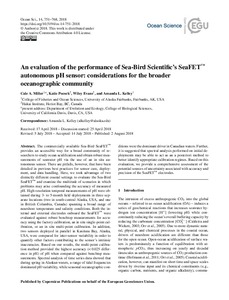| dc.contributor.author | Miller, Cale A. | |
| dc.contributor.author | Pocock, Katie | |
| dc.contributor.author | Evans, Wiley | |
| dc.contributor.author | Kelley, Amanda L. | |
| dc.date.accessioned | 2019-03-08T17:04:10Z | |
| dc.date.available | 2019-03-08T17:04:10Z | |
| dc.date.issued | 2018 | |
| dc.identifier.citation | Cale A. Miller, C.A.; Pocock, K.; Evans, W.and Kelley, A;L. (2018) An evaluation of the performance of Sea-Bird Scientific’s SeaFET™ autonomous pH sensor: considerations for the broader oceanographic community. Ocean Science, 14, pp.751–768. DOI: 10.5194/os-14-751-2018 | en_US |
| dc.identifier.uri | http://hdl.handle.net/11329/877 | |
| dc.identifier.uri | http://dx.doi.org/10.25607/OBP-424 | |
| dc.description.abstract | The commercially available Sea-Bird SeaFET™
provides an accessible way for a broad community of researchers to study ocean acidification and obtain robust measurements of seawater pH via the use of an in situ autonomous sensor. There are pitfalls, however, that have been
detailed in previous best practices for sensor care, deployment, and data handling. Here, we took advantage of two
distinctly different coastal settings to evaluate the Sea-Bird
SeaFET™ and examine the multitude of scenarios in which
problems may arise confounding the accuracy of measured
pH. High-resolution temporal measurements of pH were obtained during 3- to 5-month field deployments in three separate locations (two in south-central Alaska, USA, and one
in British Columbia, Canada) spanning a broad range of
nearshore temperature and salinity conditions. Both the internal and external electrodes onboard the SeaFET™ were
evaluated against robust benchtop measurements for accuracy using the factory calibration, an in situ single-point calibration, or an in situ multi-point calibration. In addition,
two sensors deployed in parallel in Kasitsna Bay, Alaska,
USA, were compared for inter-sensor variability in order to
quantify other factors contributing to the sensor’s intrinsic
inaccuracies. Based on our results, the multi-point calibration method provided the highest accuracy (< 0.025 difference in pH) of pH when compared against benchtop measurements. Spectral analysis of time series data showed that
during spring in Alaskan waters, a range of tidal frequencies dominated pH variability, while seasonal oceanographic conditions were the dominant driver in Canadian waters. Further, it is suggested that spectral analysis performed on initial deployments may be able to act as an a posteriori method to better identify appropriate calibration regimes. Based on this evaluation, we provide a comprehensive assessment of the potential sources of uncertainty associated with accuracy andprecision of the SeaFET™ electrodes. | en_US |
| dc.language.iso | en | en_US |
| dc.rights | Attribution 4.0 | * |
| dc.rights.uri | http://creativecommons.org/licenses/by/4.0 | * |
| dc.subject.other | pH | en_US |
| dc.title | An evaluation of the performance of Sea-Bird Scientific’s SeaFET™ autonomous pH sensor: considerations for the broader oceanographic community. | en_US |
| dc.type | Journal Contribution | en_US |
| dc.description.refereed | Refereed | en_US |
| dc.format.pagerange | pp.751–768 | en_US |
| dc.subject.parameterDiscipline | Parameter Discipline::Chemical oceanography | en_US |
| dc.subject.instrumentType | Instrument Type Vocabulary::pH sensors | en_US |
| dc.bibliographicCitation.title | Ocean Science | en_US |
| dc.bibliographicCitation.volume | 14 | en_US |
| dc.description.bptype | Guide | en_US |
| obps.contact.contactemail | alkelley@alaska.edu | |
| obps.resourceurl.publisher | https://www.ocean-sci.net/14/751/2018/os-14-751-2018.pdf | en_US |
 Repository of community practices in Ocean Research, Applications and Data/Information Management
Repository of community practices in Ocean Research, Applications and Data/Information Management

